Kayaking the waters that shaped New York City
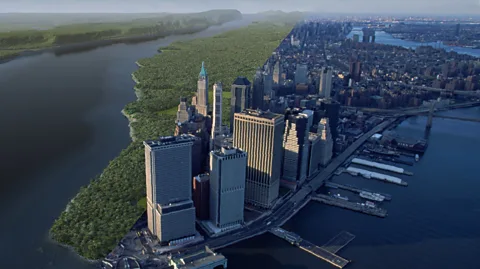 Markley Boyer & Eric W Sanderson, from Mannahatta: A Natural History of New York City
Markley Boyer & Eric W Sanderson, from Mannahatta: A Natural History of New York CityAs NYC turns 400, one of the best ways of understanding what propelled the city's astronomical growth is by paddling the rivers that built it.
Somewhere near Inwood Hill Park, home to the last native forests on the island of Manhattan, the jackhammering racket of the city softened and an orchestra of crickets trilled in unison. I paddled closer to the water's edge, where a tangle of gnarled tree roots gripped boulders deposited during the last Ice Age. Just then, a great blue heron swooped low, landing on a small sandy cove before disappearing into the reeds towards the last remnant of the original salt marshes that once surrounded Manhattan.
"Finally," I thought, after spending the day kayaking around one of the most man-made places on the planet. "Maybe this is something the island's original residents might recognise."
This year marks the 400th anniversary of the founding of New York City – or, more accurately, the Dutch settlement of New Amsterdam that would grow to become one of the world's greatest cities. It's a complicated milestone, and for years officials have been grappling over what, if anything, they should do to observe the event.
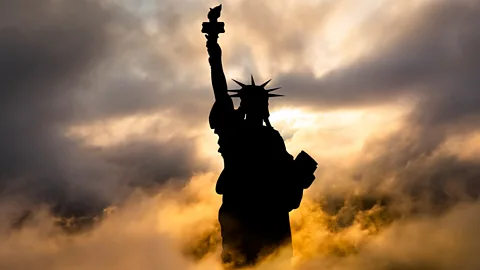 Getty Images
Getty ImagesAs Russell Shorto, author of the best-selling book The Island at the Center of the World explained, this tiny Dutch settlement effectively birthed "the world's first modern city" – a place powered by pluralism and capitalism under the promise that anyone, regardless of where they came from, could make something of themselves.
"If what made America great was its ingenious openness to different cultures, the small triangle of land at the southern tip of Manhattan island is the birthplace of that idea: this island city would become the first multiethnic, upwardly mobile society on America's shores, a prototype of the kind of society that would be duplicated throughout the country and around the world,'' he writes. More so than Boston, Plymouth Rock or Jamestown, "Manhattan is where America began."
At the same time, the Dutch created this multiethnic society by removing Native people from their lands and importing enslaved Africans to build much of Lower Manhattan. "They brought tolerance and intolerance; capitalism and colonialism. We have to process both of these things in a nuanced way that acknowledges their achievements and failures," Shorto told the BBC.
As a result, the few events honouring the city's quadricentennial have tried to carefully balance how this settlement forever shaped the nation with its dark legacies of land dispossession and slavery. "We're viewing this anniversary more as a commemoration as opposed to a celebration," said Sarah Cooney, the executive director of the Holland Society of New York, which is co-sponsoring a picnic on 14 September at Governors Island, where the Dutch landed in 1624 before permanently settling in southern Manhattan soon after.
Those early immigrants never could have foreseen that the far-flung fur trading outpost they established would one day rise to become the most linguistically diverse city in history, nor that it would play host to a remarkable experiment that continues to this day: to see whether all the peoples of the world could live together in a single place.
 Getty Images
Getty ImagesIn many ways, Manhattan stands as the ultimate triumph of man over nature. But while it may be tempting to view it today less as an island and more as a cement reef covered by steel skyscrapers and manicured parks, the story of how this relatively small 23-square-mile enclave grew to become the economic capital of the world is directly attributable to a natural phenomenon many New Yorkers have long forgotten: its access to water.
"It's all about the water. The entire city is about the water," said Captain Jonathan Boulware, the president and CEO of the South Street Seaport Museum in Manhattan. "The growth of New York into the city we know today as a global capital, a cultural capital and a multicultural city, every single aspect of its identity is rooted in water and its connections to the rest of the world."
And so, as the city reflects on the many things that have made New York "New York" over the last 400 years, I lowered myself into a kayak and set out on a 30-mile circumnavigation of Manhattan in hopes of better understanding the one thing that made it all possible. It turns out that this nine-hour journey isn't just one of the most unique ways of seeing New York City, but a dramatic reminder of how Manhattan is rediscovering its relationship to the very rivers that shaped it.
A front door into the New World
In 1609, Henry Hudson, an English explorer hired by the Dutch to find the fabled Northwest age to Asia, steered his ship from the churning waters of the Atlantic into an immense protected bay. He pushed 150 miles upstream on the mile-wide river that would one day bear his name, hoping it led to China. It didn't. But while Hudson had failed to find a faster route to the riches of the East, he stumbled on one of the world's largest natural harbours.
Sheltered from the sea's wrath by Staten Island and Long Island and stretching across a 770-mile network of navigable waterways extending into the continent's interior, this geographical gem wasn't just "a safe and convenient haven, wherein 1,000 ships may ride in safety", as the Dutch chronicler Adriaen van der Donck wrote in 1650, but a front door into the untapped resources of the New World.
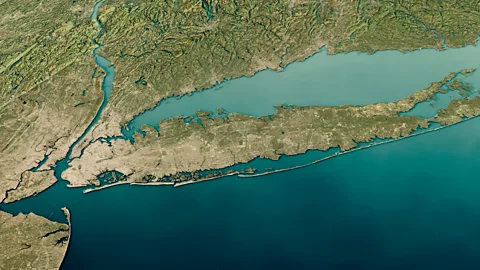 Getty Images
Getty Images"The harbour of New York is like no other. It's a marvel. It's wide, it's so deep it rarely freezes and it serves as the nexus for two bodies of water [the Hudson and East rivers] that come together to transport goods," said Dr Louise Mirrer, president and CEO of the New-York Historical Society.
This immense commercial potential is what attracted the Dutch to Manhattan from the start. At a time when the most efficient way to move cargo over long distances was by water, the Dutch Republic catapulted from relative obscurity to become one of the wealthiest and most powerful nations in the world by controlling maritime trade. It's also what made Manhattan distinct from other early US settlements. Unlike the Puritans who founded Boston, the Quakers who came to Philadelphia and the Catholics who arrived in Maryland, the Dutch didn't settle Manhattan to worship in peace; they came to make money.
"The Dutch basically created a colony dedicated to capitalism. They didn't really care about religion; they were open to anybody involved in commerce," said Dr Gretchen Sorin, a historian and the director of the Cooperstown Graduate Program at the State University of New York at Oneonta. "And so from the very beginning, New York has always been an incredibly diverse place." According to one document, by 1646 the island was home to some "400-500 men of different sects and nations" speaking about "18 different languages".
But as Shorto explained, "Manhattan was a cultural crossroads long before Europeans arrived there. It wasn't just the Lenape who used it to fish and exchange goods, but also the Shinnecock and other [Native Algonquin] peoples from the whole region who came to take advantage of the harbour and rivers."
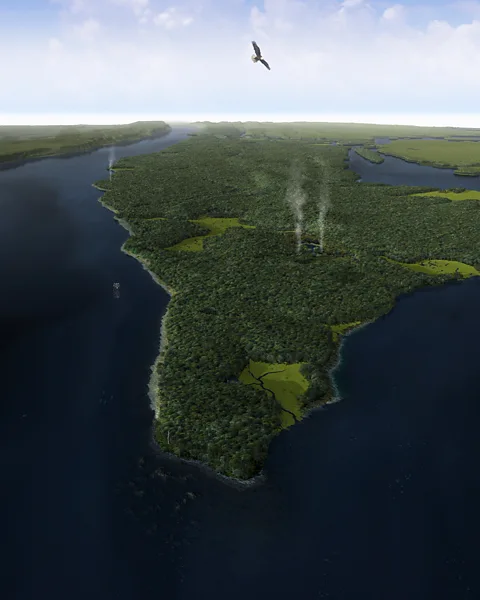 Markley Boyer & Eric W Sanderson, from Mannahatta: A Natural History of New York City
Markley Boyer & Eric W Sanderson, from Mannahatta: A Natural History of New York CityAfter the Dutch purchased Mannahatta or "Island of Many Hills", as it was known, from the Lenape in 1626, more and more seafaring entrepreneurs poured into the harbour to navigate up these rivers, shipping beaver pelts, tobacco and grain from the continent's interior back to Europe. The Dutch eventually declared the settlement a free-trade zone in 1640, and by the time the British took it at cannon point in 1664 and renamed it after the Duke of York, this ambitious, polyglot little seaport had planted the seeds of religious tolerance, individualism and enterprise that would eventually spread across the nation.
Mannahatta: An ecological oasis
When the Dutch arrived on Mannahatta, it was a stunningly biodiverse place. In his book Mannahatta: A Natural History of New York City, landscape ecologist Eric W Sanderson details that in 1609 the island was home to 66 miles of rivers and streams, 233 species of birds, 32 types of reptiles and amphibians, 70 kinds of trees, 24 species of mammals and 55 different ecosystems – which is more, per acre, than Yosemite and Yellowstone or a typical coral reef or rainforest of the same size. "If Mannahatta existed today as it did then," he writes, "it would be the crowning glory of American national parks."
The British soon sured the Dutch as the greatest maritime empire on Earth and Manhattan became a nexus point for the flow of goods and people around the globe. Coopers, blacksmiths, sailmakers and shipbuilders began flooding to the island city, and by the 1770s, New York had become "the breadbasket of the Atlantic", shipping wheat and timber to Britain and importing rum, molasses and sugar – as well as enslaved people – from the Caribbean and Africa. The city would burn at the end of the American Revolution, but over the next few decades, it would become the largest place in the western hemisphere – all thanks to water.
In 1795, New York replaced Philadelphia as the country's main port, and as more ships from around the world flooded in and out of the harbour, the city expanded north from the southern tip of Manhattan at astonishing speed. Old Dutch farms and English estates were quickly carved up into smaller and smaller plots until DeWitt Clinton (arguably the greatest or worst New Yorker in history) spearheaded two ideas that would forever change Manhattan.
The first was to level the entire natural geography of the island to accommodate its growing seaport. In 1811, the city filled in its marshes, paved over its spring-fed ponds and levelled the oak and hemlock forests where wolves and bear once roamed, replacing it all with a massive 11,000-acre street grid that turned this "island of hills" into an island of rectangles.
 Alamy
AlamyThe second was the construction of a 363-mile-long ditch connecting the Hudson River to the Great Lakes. When the Erie Canal opened in 1825, it not only paved the way for Manhattan to become an industrial juggernaut by giving it direct water access to the Midwest, but transformed the young nation by allowing the mass movement of goods, ideas and people across the country. The city was on its way to becoming the busiest port in the world and the centre of a new global supply chain connecting the continent with the rest of the globe. As Manhattan exploded with industry and became the place to do business, so many immigrants steamed into the harbour that according to Census records, by 1860 nearly 70% of adults in New York City were born outside the US.
Manhattan: America's emporium
The book Gotham: A History of New York City to 1898 reveals that by 1836, 62% of all imports to the US came through Manhattan, and on a single day that year, 921 boats on the East River waited to dock on South Street, while an another 320 waited on the Hudson.
"If you look at aerial photos of Manhattan [in the late 1800s and early 1900s], it's so completely ringed with piers that it looks like a porcupine," Boulware said. "These ships were coming from all over the world to load and unload cargo, and there were a lot of entrepreneurs trying to creatively turn $5 into $6 on those docks. It was an early example of the New York hustle. This is the DNA of the city and the port and water is the core of it."
As planes started replacing enger liners and container ships were diverted to New Jersey in the 1950s, Manhattan's maritime industry began to collapse. Over the coming decades, piers and warehouses were abandoned, docks fell into decay and New York Harbor, which had been one of the most diverse and dynamic environments on the planet when the Dutch showed up, became a de facto dump.
But in the last decade, billions of dollars have been pumped into cleaning up the city's waterways, a string of ambitious projects have transformed Manhattan's rusting piers into landscaped green spaces and the city's once-derelict waterfront has become a model of urban renewal. As a result, more than four centuries after Hudson's crew reported that waves of Lenape came out to greet their ship in "great canoes" as they approached the island, Manhattan is returning to its water-bound roots, and quickly emerging as one of the US's most unique paddling destinations.
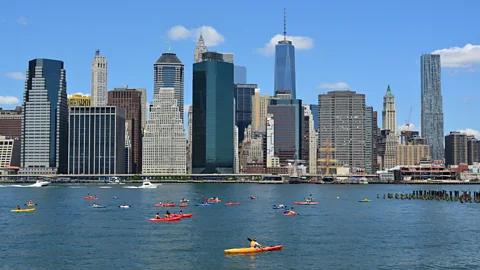 Alamy
Alamy"There's no place like it in the country," said Suzy Basu, managing partner of Manhattan Kayak Co, which offers hourly rentals, classes and guided tours around the city – including a 30-mile lap of Manhattan. "So many people here don't even realise Manhattan is an island, but when you paddle around this magnificent, man-made mountain range of towers shooting into the sky, it changes your whole perspective of the city. You'll see."
Kayaking Manhattan
Pushing out of Pier 84 and into the Hudson's swift tidal flow, it quickly became clear that the key to navigating Manhattan's waterways on your own power is something the island's Indigenous residents understood long ago: it's all about the current.
The original Algonquin name for the Hudson River was Mahicantuck or "river that flows two ways". That's because, like the East River that rings Manhattan's opposite end (which isn't actually a river but a tidal strait), its current changes direction every few hours as it flows in and out of the ocean. Therefore, our floating parade of 14 kayakers and four stand up paddleboarders would travel counterclockwise around the island in a perfectly timed route designed to take advantage of the rivers' shifting currents.
Accompanying us were three guides armed with two-way radios whose job was to safely navigate us through the rush of ferries, barges and sightseeing cruises – one of whom was Eric Stiller, Manhattan Kayak Co's 64-year-old founder, who estimates he's circumnavigated the island 80 to 100 times. He explained that back in the 1980s, there was no access to the water for paddlers anywhere, so he used to jump fences and launch his foldable kayak in the Hudson from rotting piers. As word of his exploits spread, people started paying him to lead them out into the rivers where no one else dared go.
"My first paying customer was [American singer] David Lee Roth, followed soon after by John F Kennedy Jr," he said, as we paddled towards the glimmering pinnacles of the Chrysler and Empire State buildings in the distance. "We used to wheel kayaks out [in the Meatpacking District], jump the fence and paddle out to Ellis Island. That's how this all started."
Fast-forward to today and the New York City Water Trail connects paddlers with 160 square miles of navigable waterways, dozens of launch sites dot the city and many of Manhattan's newly opened boathouses now offer free kayaking.
As the current carried us south along the 550-acre Hudson River Park that runs along Manhattan's western shore, the island's recent waterfront revival unfolded in front of us. Since first opening in 1998, the park has been slowly transforming many of the collapsing piers that once propelled the city's growth into creative urban oases – all while paying homage to Manhattan's maritime past and incorporating native ecosystems that thrived here 400 years ago.
We soon paddled past Little Island, a $260m "floating park" rising like a bouquet of tulip-shaped concrete columns from the Hudson that opened in 2021. Built atop the former Cunard Line dock that shipped people and goods between Manhattan and the British Empire (and next to the pier where the survivors from the Titanic landed in 1912), it's home to 350 species of flowers, trees and shrubs that Mannahatta's early residents would recognise today.
Moments later, we drifted past Gansevoort Peninsula, where novelist Herman Melville spent years working as a customs inspector at the wharf after writing Moby Dick. Opened in 2023, the park features a restored marsh, native grasses and a 1,200-ton sand beach designed to mirror those that lined the island's western shore when the Dutch arrived.
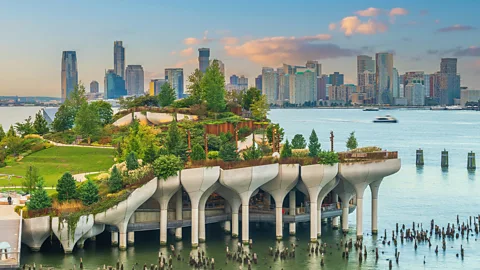 Getty Images
Getty ImagesTribeca's 2.5-acre "ecologically themed" Pier 26 then came into view, where a newly planted woodland forest, coastal grassland and maritime scrub is designed to mimic the river's original coastal habitat. A brand-new "estuarium" opened in January 2024 featuring a playground inspired by fish species that thrived in the Hudson before European colonisation, and as I looked to my left, I spotted children climbing into the gills of a colossal Atlantic sturgeon.
Work is underway on the other side of Manhattan, too, where the East Midtown Waterfront project is part of a grand vision to close the loop and provide New Yorkers with continuous waterfront open space around Manhattan once it's completed in 2026.
As we approached the southern tip of Manhattan where the Dutch settled, a sudden "Hold!" command from Stiller thrust me back into the present. Four centuries later, these waters remain Manhattan's busiest maritime throughfare. With boats and barges rumbling all around us, Stiller explained that once he gave the signal, we had exactly 10 minutes to round the island's southern point before the next Staten Island ferry stormed by.
I glanced over at the Statue of Liberty and Ellis Island on my right, One World Trade Center on my left and snapped a quick picture with my phone. Then, one of our guides, Tommy Montgomery said, "You're going to want to secure that now before we get to Hell Gate."
"Before we get to what">window._taboola = window._taboola || []; _taboola.push({ mode: 'alternating-thumbnails-a', container: 'taboola-below-article', placement: 'Below Article', target_type: 'mix' });
